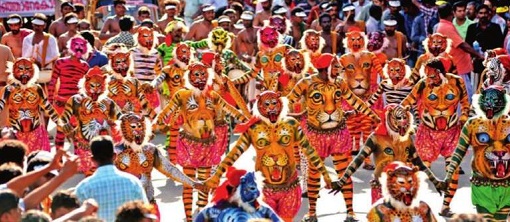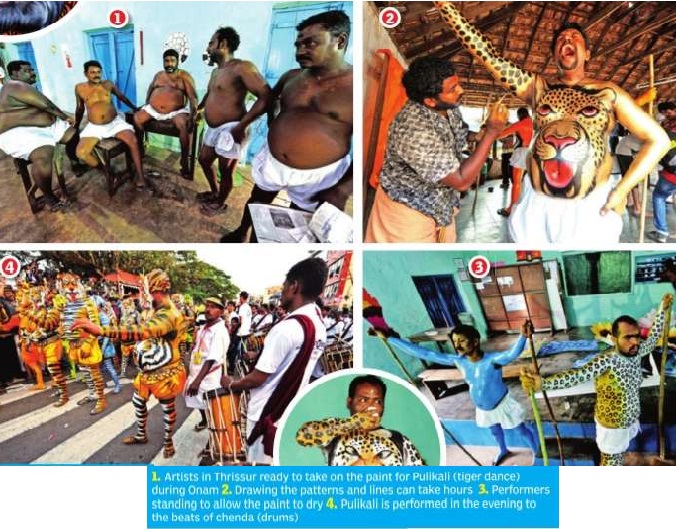Thrissur Pulikali (Tiger dance)


This is a collection of articles archived for the excellence of their content. |
History
The Times of India, Sep 03 2015
B A Raju & M T Saju
Thrissur Pulikali (tiger dance) during Onam may be synonymous with big bellies, but artists say it is a latterday innovation meant to entertain audiences.
At a time when people work hard to reduce their waistlines, pro truding bellies are in demand here. The bigger the belly, the better the chance of displaying it in public in vibrant colours. On the fourth day of Onam in Thrissur, the belly becomes a symbol of majesty and ferocity through Pulikali (tiger dance). In Pulikali, a folk dance form prevalent in the central region of Kerala, the artist's belly becomes a tiger that wriggles and sways to the beat of the chenda (drum). Eight teams, each with 30 members, assembled in Thrissur on Monday for the annual Pulikali. The organizers start scouting for the artists bellies many weeks before Onam, says Anand PK, an expert in the art form.
A big belly pays well. “One can earn at least Rs7,000 for one performance if he has a great paunch,“ he adds.
Pulikali dates back more than 200 years.“It was the Cochin ruler, Sakthan Thampuran who introduced the art form to celebrate Onam. But the folk art form has undergone a lot of changes,“ said T R Antony, who performed his 38th Pulikali in Thrissur.
Though the tiger dance is old, the big belly is a latter-day innovation it makes Pulikali a spectacle. “Earlier we didn't use masks. Today we do. Even make-up has undergone a lot of changes,“ says Antony , who is 68 years old.
On the day of the `kali', the work of painting the bellies starts early . “The work starts in the morning for the evening event,“ said Anand.
First the artists apply egg-white on their bodies and walk around for an hour. Then they apply coconut oil and prepare for a bath. “After this, our skin is ready to take the paint. The lines can be drawn easily now,“ says Antony .
While Antony laments that the changes are destroying traditions, K Surendran, another artist, says today's audiences want fun and the bellies provide it. The dance is still there, he assures. “I am proud of my paunch and I maintain it well,“ says Surendran, who has been performing for ten years.